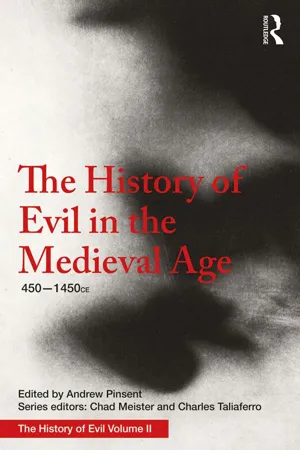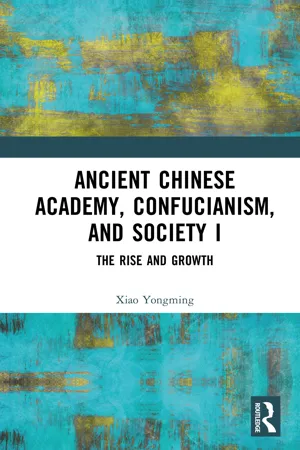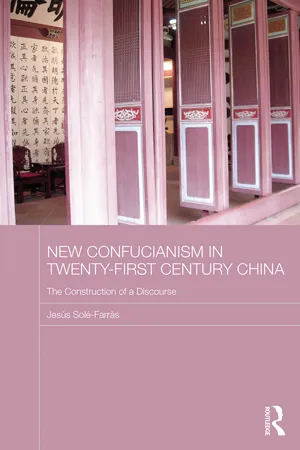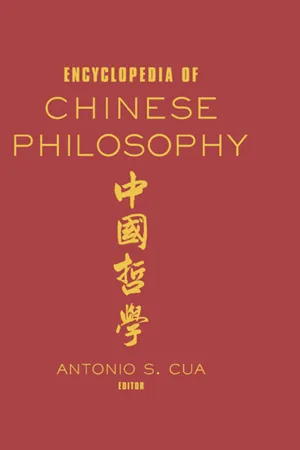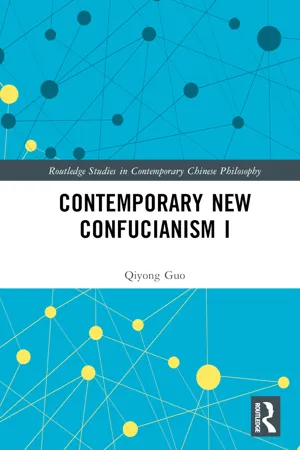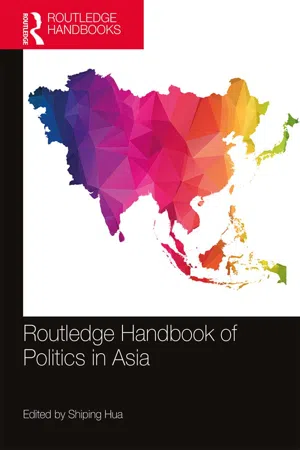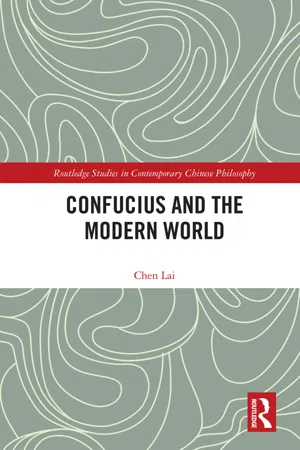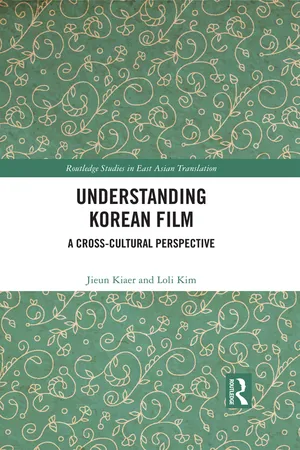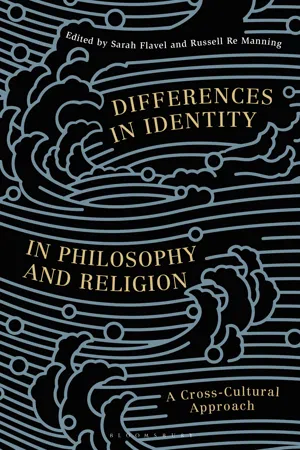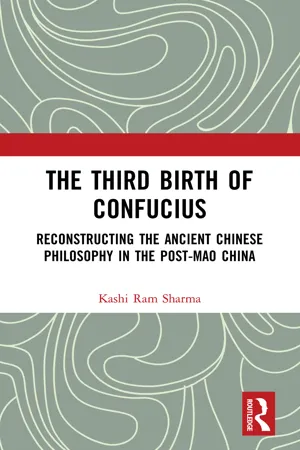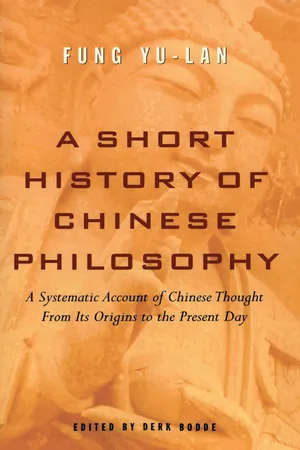History
Neo Confucianism
Neo-Confucianism was a philosophical movement that emerged in China during the Song dynasty. It integrated Confucianism with Buddhist and Daoist elements, emphasizing moral cultivation, self-discipline, and the pursuit of knowledge. Neo-Confucianism had a significant impact on East Asian societies, influencing government policies, education, and social values.
Written by Perlego with AI-assistance
Related key terms
11 Key excerpts on "Neo Confucianism"
- eBook - ePub
The History of Evil in the Medieval Age
450-1450 CE
- Andrew Pinsent, Chad Meister, Charles Taliaferro(Authors)
- 2018(Publication Date)
- Routledge(Publisher)
4 Neo-Confucianism Yong Huang Confucianism, neo-Confucianism and its schools Confucianism was only one of the so-called one hundred schools of the Spring-Autumn (722–477 bce) and Warring States (476–221 bce) periods. During the first two unified dynasties of China, attitudes to Confucianism went through some dramatic changes. While Confucianism was banned in the Qin dynasty (221–206 bce), which practiced Legalism, it eventually became the state ideology in the Han dynasty (206 bce –220 CE). Its influence gradually decreased later, however, with the rise of neo-Daoist philosophy and religious Daoism and, more importantly, the introduction of Buddhism from India to China. During the Sui 隋 (581–618 CE) and Tang 唐 (618–907 CE) dynasties, Buddhism eclipsed Confucianism as the dominant state ideology. Confucianism started to revive in the Song 宋 dynasty (960–1279 CE), and continued in the Yuan 元 (1271–1368 CE), Ming 明 (1368–1644 CE), and, in a certain sense, Qing 清 (1644–1912 CE) dynasties. Classical Confucianism, however, focuses on everyday life rather than metaphysics. Hence, in order to respond to the challenges coming primarily from Buddhism, which is strong in metaphysics, Confucians in this period attempted in various ways to provide metaphysical foundations for classical Confucianism, often by borrowing from Buddhism. This borrowing was facilitated by the fact that most Confucians during this revival were either former Buddhists, or continued to be Buddhists to a certain extent, or were at least well versed with Buddhist literature - eBook - ePub
Ancient Chinese Academy, Confucianism, and Society I
The Rise and Growth
- Xiao Yongming(Author)
- 2022(Publication Date)
- Routledge(Publisher)
4The Academy and Neo-Confucianism in the Song and Yuan DynastiesDOI: 10.4324/9781003332282-4The origin, development, and subsequent boom of Neo-Confucianism (also known as Li Xue) during the period of the Song and Yuan dynasties was remarkable in Chinese thoughts and cultural history. The academy system, in its advancing process, came to form a binding and mutually reinforcing relationship with Neo-Confucianism, which relied on academies to come into being, develop, and disseminate and in turn, prospered the development of academies. Although quite a few scholars noticed the intertwining bond between the academy system and Neo-Confucianism, they had yet to make an explicit explanation as to the bond and mutual impact. The study focus on the link between the academy system and Neo-Confucianism was more put on the political environment during that period rather than on an exploration of deeper internal causes. This chapter will make an attempt to illustrate and explore the concrete link and mutual influence between the academy system and Neo-Confucianism during the Song and Yuan dynasties, discussing and analyzing the inner drive that integrated the two.Neo-Confucianism in the Song and Yuan
Since the beginning of the Song dynasty, the development of Confucianism had reached a new phase. Some Confucian scholars stood up bravely to face the predicament that Confucianism was in and responded to new problems raised by society in a new time. These scholars chose to undertake the noble mission to ordain conscience for heaven and earth, to secure life and fortune for the people, to continue the lost teachings of past sages, and to establish peace for all future generations. Endowed with a sense of mission as such, they integrated voluminous Buddhist and Taoist thoughts with relevant theories and research fruits, updating and advancing traditional Confucianism and eventually having a consummate and sophisticated Neo-Confucianism constructed. The overall constructing process and its later development and dissemination, though repeatedly met with setbacks, was recognized and acknowledged in the end in the late Southern Song. The Yuan dynasty went ahead further and valued Neo-Confucianism as the top of a series of study theories, thus becoming official thoughts. There were in all approximately three phases in the growth process during the period of the Song and Yuan dynasties, which were the initial formation in the middle and late Northern Song dynasty, the advancement and maturation in the early and middle Southern Song dynasty, and the gradual establishment of the official status in the late Song and Yuan dynasties. - eBook - ePub
New Confucianism in Twenty-First Century China
The Construction of a Discourse
- Jesús Solé-Farràs(Author)
- 2013(Publication Date)
- Routledge(Publisher)
The intellectual activity of the thinkers of the first generation of New Confucianists represents the demand, from the viewpoint of critical self-consciousness, for a public space for the Confucianist discourse. A discourse that they initiate by establishing certain basic long-haul postulates, since they are borrowed from the past in order to found a future philosophical and ideological movement. Essentially, they establish that Confucianism is the backbone of Chinese culture, and that Neo-Confucianism is its fundamental philosophy. Thus, they recoup the religious dimension of Confucianism in order to rediscover the spiritual roots of current China; they identify harmony as the basic element of Confucianism and Chinese culture, and see in metaphysics the basis of an authentic philosophy of life. They posit ethics as a priority, to the point that they believe that the spirit of the historical evolution of China is the search for moral truth, and that personal ethical maturity, attained through self-cultivation, is the necessary condition for social activity. In spite of the fact that they defend the superiority of Chinese culture and Confucianist values – Chinese culture as substance and Western culture as function – they say that the values other cultures must be respected; thus, the modernization of China must have basic Confucianist values, while taking advantage of everything, duly adapted to Chinese culture, that is useful from other cultures, especially, Western science. Consequently, there is a tendency to defend an ideal ethical thought that would arise by harmonizing traditional Confucianist ethics, the Neo-Confucianist ethics of the moral self and the Western ethical idea of free will. Finally, they defend a social order that is the result of reason and not force, and a political doctrine which, without copying foreign models, combines rule by virtue and the rule of law. - eBook - ePub
- Antonio S. Cua, Antonio S. Cua(Authors)
- 2013(Publication Date)
- Routledge(Publisher)
It was in this sense that the core of Confucianism as a philosophy and as a faith became prominent and spoke out as a new force in the 1930s, as exemplified in the formulations of Xiong Shili, Liang Shuming, and others. This was the rise of “new Confucianism” in modern and contemporary China. Without an understanding of the background—the collapse of Confucianism as a political and social force—we could not appreciate the source of its inspiration and strength. And without an understanding of its roots in classical Confucianism and Song-Ming neo-Confucianism we could not appreciate its creative strength and vision.In retrospect, the rise of contemporary neo-Confucianism as a philosophy was not a historical accident. It was, rather, the way Confucian philosophy, deprived of political and social backing, responded to a challenging situation. This way of understanding contemporary neo-Confucianism helps us see how it was related to basic cultural, ethical, and metaphysical concepts in classical Confucianism and Song-Ming neo-Confucianism. The crucial question is how Xiong Shili (1885–1968) and Liang Shuming (1893–1988) came to formulate the Confucian philosophy and the Confucian faith against the historical background of the 1920s and 1930s after the May Fourth movement.One factor we need to take into account is that no western philosopher known at the time—neither Darwin, Huxley, Bergson, Russell, nor Dewey—had provided ethics or metaphysics that could satisfy the minds of Chinese Confucian intellectuals, who tended to look for deeper truths in Chinese Buddhism. That both Xiong and Liang studied Buddhism before they turned back and formulated their philosophies of Confucianism shows that they searched for spiritual truth beyond political and social reality. Nevertheless, their return to Confucian philosophy needs an explanation. They were concerned with the actual state of society and the practical issues of cultural life, as they had demonstrated in their early engagement in social, political, and cultural matters. Hence, it was natural for them to go back to Confucian philosophy, and in this regard they were typical of many others.Of these two, Liang, who was younger than Xiong, represents a retrieval of the Confucian faith. He identified three types of cultural spirit: the western, which took at its principle simply moving forward; the Indian, which took looking backward as its guiding principle; and the Chinese, whose guiding principle was harmony and a centralized balance. This theory provided a justification of Chinese culture but also suggested a way for the necessary development of the culture. What accounted for these types of culture? For an answer, we must look into human nature and the human mind. Liang held that our desires made us seek external material satisfaction, our moral intuition (liangzhi - eBook - ePub
- Qiyong Guo(Author)
- 2023(Publication Date)
- Routledge(Publisher)
There is no absence of democratic seeds in Confucianism, such as admiring the revolution of King Tang and King Wu and attaching importance to public opinion, selection of talents, freedom of speech, and opposing the world for the private but advocating for the whole world as one community (Tian Xia Wei Gong 天下 为公). The village conventions advocated by Confucianism in the Song and Ming dynasties are in line with western civic education and local autonomy. He believes that Song Dynasty culture is comparable to the European Renaissance in the history of Chinese thought. Scholars in the Song Dynasty were brave to doubt and innovate. The Song Dynasty had a variety of styles of literature, such as poetry, popular language styles, philosophers’ quotations, Pinghua (平 话), and popular novels that are proper for common people. Various academic developments were advanced, with high achievements in Neo-Confucianism and classics, history, textual research, and epigraphy, with a strong interest in fine arts. Movable typography promoted cultural prosperity, especially the rise of Neo-Confucianism, resistance to Buddhism, emphasizing the spirit of rational autonomy. All of these are similar to the struggle between European Protestantism and Catholicism. Zhang Junmai (张君劢) believes that the thought system of Song-Ming Neo-Confucianism can be divided into four categories: cosmology, self-reflection (nature, heart-mind, reason, knowledge), academy education, and political system. He argues that the key to social progress and national rejuvenation is the revival of Confucianism. The revival of Confucianism is the revival of the basic spirit of Confucianism since Confucius, Mencius, and Confucianism in the Song dynasty, and the reconstruction of the spirit of the Chinese nation, which is the basis of China’s modernization - eBook - ePub
- Shiping Hua(Author)
- 2018(Publication Date)
- Routledge(Publisher)
The term “Rise of East Asia” refers to the fact that East Asia experienced fast economic growth from the 1960s to the 1990s. After World War II, the economies of these countries took off one after another. Japan took the lead and became the world’s second-richest and advanced nation in two decades; South Korea, Taiwan, Hong Kong, and Singapore, the so-called “Four Little Dragons,” quickly followed, and finally, China began to rise in the 1980s. All these East Asian countries were the world’s top economic performers in the postwar era. It only took less than half a century from the Japanese economic miracle to China’s rise. East Asia reached a high level of modernization in fifty years, but Western countries took about two centuries to complete the same task. Why were these East Asian countries able to become the world’s fastest-industrializing nations in a short period of time? One explanation is that they benefited not only from the developed nations but also from their common cultural tradition—Confucianism. All East Asian countries are culturally within Confucian order (Morishima 1982, 15). It is Confucianism that shapes social ethical codes and governing principles, and brings about sustained economic progress in East Asia.Development of Confucianism in East Asia
Confucianism is different from the original teaching of Confucius. The term “Confucianism” was invented by Westerners in modern times to categorize the East Asian cultural tradition from a Western perspective. Confucius, the founder of Confucianism, was born in 551 B.C. during the Warring States Period in which China was in a great transition from a heredity system to a feudal society. The Four Books (The Analects, Mencius, The Doctrine of Mean , and The Great Learning ) and the Five Classics (The Book of Changes, The Book of History, The Book of Songs, The Book of Rites , and The Spring and Autumn Annals ) represent the authority of Confucius’s teaching. Only these works, which recorded Confucius’s teaching, can be categorized as authentic Confucian works. The basic concept of his teaching is based on the five constant virtues: jen (benevolence), yi (righteousness), li (propriety), zhi (knowledge/wisdom), and xin (sincerity). His main teaching comprises three cardinal guides: Ruler guides subject, father guides son, and husband guides wife. All these Confucian principles deal with human relationships and social order. Confucian social utopia is the harmony of the individual, the group, and the country. Therefore, Confucius’s teaching at its inception was not an economic theory but a strong conservative political and ethical philosophy aiming to restore the heredity system (Lin 1942, 3).The original intention of Confucius’s teaching was to restore trust in the government, transform society into a moral community, bring comfort to the old, have trust in friends, and cherish the young by practicing the five constant virtues. In Confucius’s time, China was experiencing a great transformation from a slavery system to a feudal system. The old social order was broken (li beng ) as wars and violence started occurring across the land in the Warring States Period. In Confucius’s eyes, the old social order was the best social order because it was compatible with li (propriety). He was determined to bring society back to the traditional system (fu li ). Ke ji fu li - eBook - ePub
- Lai Chen(Author)
- 2018(Publication Date)
- Routledge(Publisher)
2 However, Tang Tong commented on the whole Chinese tradition, saying,Obviously, the humanistic view of nature here obviously includes Confucianism.Chinese tradition is quite different. It neither struggles to conquer nature nor studies and understands nature. Its goal is to conclude an agreement with nature and to realize and maintain harmony … such a wisdom, combining the subjective and the objective bodies into one, guides man to harmonize the relationship between human and nature… . Chinese tradition is humanistic in the integral sense.3To meet the needs of global sustainable development in the 21st century, recent efforts have been made in the world to search for a new ecological worldview and to establish a more rational view of nature and practical spirit. Ancient oriental cultural traditions have become one of the important resources to develop new ecosophy. The Taoist school seems to have won more attention in this regard. This chapter aims to illustrate the ecological orientations of Confucianism, especially those included in Song-Ming Neo-Confucianism, as well as the idiosyncrasy it involves.Two
Early representative figures of New Confucianism had a special feeling and concern over nature in which the lives of living beings go on without end. For example, Zhou Dunyi (1017–1073), a government official and a Neo-Confucianist in the Northern Song Dynasty, was the earliest ancestor of Neo-Confucianism. Historical records show that by the window of his residence weeds grew in wanton profusion, but he never had them mowed. When asked why, he replied, “Outside the window the grass is as vigorous as my heart”. This remark recorded in Er Cheng Yi Shu Part III (The Analects of Cheng Hao and Cheng Yi) not only expresses a thought, namely, the life of an individual is akin to other natural lives, but also embodies his ambition of integrating man with ever-lasting nature. The Analects of Cheng Hao and Cheng Yi has it that “observing all manifestations of nature (read by Zhou Maoshu)” (from The Analects of Cheng Hao and Cheng Yi - eBook - ePub
Understanding Korean Film
A Cross-Cultural Perspective
- Jieun Kiaer, Loli Kim(Authors)
- 2021(Publication Date)
- Routledge(Publisher)
3 The Korean cultural context DOI: 10.4324/9781003089896-3Confucianism is the primary cultural context for understanding Korean interactions and subsequently for understanding K-films. In this chapter, we will provide a brief history of Confucianism in Korea – from the neo-Confucianism of the pre-modern era to its mutation into the Confucianism of contemporary Korea – focusing throughout on the fundament of the ideology Oryun, which underpins the system of Korean interpersonal relations. We will explain how this ideology continues to function similarly in contemporary Korea as it did during the period of neo-Confucianism, and how it has changed to be more fitting with the demands of contemporary Korean lives in Korea’s diversifying, globalising society. This provides the Korean context within which K-films must be placed in order to understand the meanings of verbal and non-verbal expressions in interactions, illustrated throughout with examples from popular K-films.3.1 Five relations: the fundament of neo-Confucianism
Confucianism was first introduced to Korea by China in the fourth century and has been the leading ideology in Korean society since around 1200. In 1392, after witnessing the barbarian Qing regime (1644–1911) overthrow Korea’s moral big brother, the Ming dynasty, Korean rulers of the newly established Joseon (also known as Yi) dynasty (1392–1897) were provoked to become even stricter than their Chinese counterparts, and thus neo-Confucianism was born. The Confucian doctrine promoted hierarchy in social roles, but the neo-Confucian ideology emphasised complete obedience in this. The system of interpersonal relations that resulted centred on family, authority, and obedience, most importantly, the Samgang Oryun, which translates as the ‘three bonds and five relations’. The Samgang, or ‘three bonds’, refers to loyalty between ruler and subject, filial piety between father and son, and the devotion of the female between husband and wife. The Oryun, or ‘five relations’, refers to the relationships between king-subject, father-son, husband-wife, between siblings, and elder-younger. The Samgang Oryun is rooted in the concept of hierarchical order, with respect being a key element of intimacy rather than emotion as it is in Western societies. This vertical perspective of relationships in Korean society placed kings over vassal, parents over children, husbands over wives, older siblings over young siblings, and the old over the young. Also, if you pay close attention, although it isn’t clearly specified in each case, you will also notice the vertical relation between genders: male over female. Here, however, we give focus to the Oryun because of its influence across Korean social interactions. The Oryun - eBook - ePub
Differences in Identity in Philosophy and Religion
A Cross-Cultural Approach
- Lydia Azadpour, Sarah Flavel, Russell Re Manning, Lydia Azadpour, Sarah Flavel, Russell Re Manning(Authors)
- 2020(Publication Date)
- Bloomsbury Academic(Publisher)
6 Confucianism in this understanding is therefore a historically conscious endeavour to continuously revise and re-evaluate the more concrete aspects of its own teachings. In this sense, it engages in a continuous overcoming of itself, which at the same time entails its constant reformation. This approach has direct bearing on interpreting the role of the individual person in Confucianism, and we shall therefore return to this topic in Section ‘Confucian “individualism”’.The daological frameworkWhat role does ontology or cosmology play in our lives? At first, it might seem to be insignificant. After all, the makeup of the world and our status within it are philosophical issues that we do not often raise in everyday conversation. In some parts of the world, however, we often talk about the weather, not only because we are desperately looking for a possible discussion topic but because the weather has such strong impact on our everyday life, the scope of possible activities and our general emotional condition. In other words, the weather affects our emotional well-being in daily life in a most direct and felt manner. But however vague our beliefs may be about our ultimate cosmic status, it would be perfunctory to dismiss the impact of cosmological affairs on our daily lives. With their lack of immediacy, the wider cosmic picture may not be an everyday issue of concern. Nevertheless, while we might not always and even rarely be fully aware of it, the cosmological context provides the deepest ground on which we stand in all our valuations, significant decisions and, indeed, general emotional attitude to life and world. We only need to think of the vast philosophical, religious and existential consequences of the paradigm shift from a geocentric to a heliocentric world view in Western culture during the post-Renaissance period to fathom the extent of the impact of our cosmological world view on the human being’s self-understanding.7Immanuel Kant’s philosophy, for instance, is an attempt to construct a metaphysics consistent with both the then rather new scientific world view emerging from Newton’s theories and the Enlightenment ethical outlook grounded on universal reason. The following passage from Kant’s Critique of Practical Reason - eBook - ePub
The Third Birth of Confucius
Reconstructing the Ancient Chinese Philosophy in the Post-Mao China
- Kashi Ram Sharma(Author)
- 2022(Publication Date)
- Routledge(Publisher)
I am not suggesting that in the above listed three dynasties, neo-Confucianism was the only dominant movement. No, every dynasty had its own list of problems and priorities. When one writes the intellectual, cultural and philosophical history of these three dynasties, then one shall have to focus on neo-Confucianism. Put in simple words, it was a movement of revival of Confucianism. Wang Yang Ming had his rise and fall, once exiled for three years, then as a military commander, he became a national hero by defeating the rebellions of 1517 and 1519 against the Ming emperor. I am not concerned here about these military and political exploits of Wang. I am singularly concerned here about his philosophical contribution to neo-Confucian thought. He wrote extensively and exhaustively on the theme of ‘extension of one’s innate knowledge’, a theme made prominent by earlier neo-Confucians. To him ‘man is born with the knowledge of what is good’ 24 and can ‘put his knowledge into action if he has a pure mind’. 25 If Zhuxi belonged to the Rationalist school or the School of Principle/Reason, then Wang belonged to the school of Mind or intuition. Wang also challenged Zhuxi’s heavy accent on book-learning. Wang underlined the role of thinking and meditating. Meditating, he argued is the only way to develop one’s mind and intuition. This, in turn – one’s intuitive thinking – will lead one to action and behaviour. To him, ‘knowledge and action were united’. 26 One of his quotable quotes is ‘knowledge is the beginning of action and action is the completion of knowledge’. 27 What a coincidence? He was recasting the well-known philosophical maxim that one who knows acts not and one who acts knows not. In a word, he preached that knowledge and action should be organically linked. His belief in the innate goodness of man was based on the premise of Mencius. Like Confucius and Mencius, he believed that every man is capable of developing himself into a sage - eBook - ePub
- Yu-lan Fung, Derk Bodde, Derk Bodde(Authors)
- 2017(Publication Date)
- Free Press(Publisher)
NEO-CONFUCIANISM: THE SCHOOL OF PLATONIC IDEAS
O NLY TWENTY-TWO YEARS AFTER THE death of Ch’eng Yi (1033-1108), Chu Hsi (1130-1200) was born in the present Fukien province. The political change that took place during these twenty years is tremendous. The Sung dynasty, although culturally outstanding, was militarily never as strong as the Han and T’ang dynasties, and was under constant threat from outside tribes in the north and northwest. Its greatest catastrophe came when it lost its capital, the present city of Kaifeng, to the Jurchen, a Tungusic tribe from the northeast, and was compelled to reestablish itself south of the Yangtze River in 1127. This event marked the division of the Sung dynasty into two lesser parts: the Northern Sung (960-1126) and the Southern Sung (1127-1279).Position of Chu Hsi in Chinese History
Chu Hsi, better known simply as Chu Tzu or the Master Chu, was a philosopher of subtle argument, clear thinking, wide knowledge and voluminous literary output. His Recorded Sayings alone amount to 140 chüan or books. With him, the philosophic system of the Ch’eng-Chu school, also known as the Li hsüeh or School of Li , reached its culmination. Though the supremacy of this school was several times to be disputed, notably by the Lu-Wang school and by certain scholars of the Ch’ing dynasty, it remained the most influential single system of philosophy until the introduction of Western philosophy in China in recent decades.In chapter seventeen I have said that the dynastic governments of China ensured the supremacy of their official ideology through the examination system. Persons who took the state examinations were required to write essays based on the official versions and commentaries of the Confucian Classics. In chapter twenty-three I also said that one of the major acts of Emperor T’ai-tsung of the T’ang dynasty was to determine the official version and “correct meaning” of the Classics. During the Sung dynasty, the great statesman and reformer, Wang An-shih (1021-1086), prepared “new interpretations” to some of these Classics, and in 1075 Emperor Shentsung ordered that Wang’s interpretations should be made official. This order, however, was soon cancelled when the political rivals of Wang An-shih gained control of the government.
Index pages curate the most relevant extracts from our library of academic textbooks. They’ve been created using an in-house natural language model (NLM), each adding context and meaning to key research topics.
